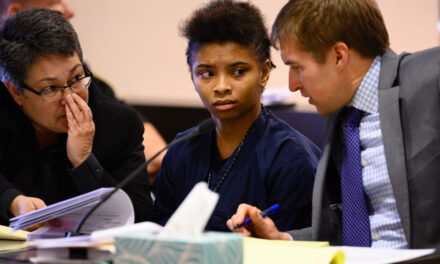
Only 1 Black Juror Chosen in Trial Over Ahmaud Arbery Case

After a grueling selection process, opening statements in the case against three white men accused of chasing down and killing Mr. Arbery are expected to begin on Friday.

BRUNSWICK, Ga. — After a grueling process that lasted two and a half weeks, a jury was selected on Wednesday in the trial of the three white men accused of killing Ahmaud Arbery, the 25-year-old Black man who was chased through a suburban Georgia neighborhood before being fatally shot by one of his pursuers in February 2020.
The jury, which is made up of residents from Glynn County, where more than a quarter of the population is Black, includes 11 white people and one Black person. Anxiety over what the jury’s racial makeup would be had been palpable among observers and participants in recent days.
Linda Dunikoski, a special prosecutor from the Cobb County District Attorney’s Office, tried on Wednesday to challenge the defense attorneys’ removal of eight Black potential jurors, citing a U.S. Supreme Court ruling that makes it unconstitutional to strike people from a jury solely because of their race.
After reviewing the eliminations one by one, Judge Timothy R. Walmsley of Glynn County Superior Court acknowledged that “quite a few African American jurors were excused through peremptory strikes executed by the defense.”
“But that doesn’t mean,” he continued, “that the court has the authority to reseat, simply, again, because there’s this prima facie case.”
The judge ruled that for each of the eight stricken jurors, the defense had provided a “legitimate, nondiscriminatory, clear, reasonably specific and related reason” as to why the potential juror should not be seated.
Judge Walmsley said the court would consider a number of motions on Thursday, with the trial expected to begin on Friday morning. Opening statements by the two sides will offer the clearest look in months at how the murder case against the three defendants — Gregory McMichael, 65; his son Travis McMichael, 35; and their neighbor William Bryan, 52 — will unfold. Each faces up to life in prison for his role in Mr. Arbery’s slaying.
Video
transcript
transcript
Ahmaud Arbery’s Final Minutes: What Videos and 911 Calls Show
Using security footage, cellphone video, 911 calls and police reports, The Times has reconstructed the 12 minutes before Ahmaud Arbery was shot dead in Georgia on Feb. 23.
-
In February, 25-year-old Ahmaud Arbery was shot dead in the south Georgia neighborhood of Satilla Shores. In the two months that followed, no arrests were made. But local residents and lawmakers protested what they said was a deadly combination of racial profiling and flawed self-defense laws. “When they stop you, make sure you got your cameras on. Make sure you got a video.” Police did eventually arrest 2 suspects, but it was days after this video of the fatal shooting emerged. Gregory McMichael and his son Travis were charged with murder and aggravated assault. The case has reignited the national debate over racial violence. “I’m sure you saw the news about Ahmaud Arbery.” “It looks like murder.” “The American public saw the video.” What exactly happened in the last moments of Mr. Arbery’s life? Using security camera footage, cellphone video, and 911 calls and logs, The Times has reconstructed the critical 12 minutes from when Mr. Arbery appeared on Satilla Drive to his death, less than 300 yards away. It’s around 1 p.m. on Feb. 23 when Ahmaud Arbery is out, less than 2 miles from his home. A security camera at 219 Satilla Drive is recording when Mr. Arbery enters the frame at around 1:04 p.m. He may have been jogging in the area, but he stops on the front lawn of 220 Satilla, a house being built across the street. Arbery glances around and wanders into the open construction site. Inside, security footage briefly captures him looking around. Meanwhile outside, a neighbor walks from Jones Road towards Satilla Drive and calls 911. The neighbor waits by the street corner. He will later tell the dispatcher that Arbery resembles a recent trespasser in the area. On multiple occasions before Feb. 23, several trespassers were caught on camera at 220 Satilla. The owner routinely alerted the police. On four occasions, what appears to be the same man was filmed. It’s unclear if this was Arbery, but even if it were, this does not justify his shooting by neighbors outside on the street. The site’s owner says nothing was ever stolen from the house during these incidents or on Feb. 23, and no property was ever damaged. But neighbors were aware of the trespasses and the community was on alert. Now, back to the day in question. It’s 1:08 p.m. and Arbery is walking around inside the house. Four minutes after he entered, he walks out and runs off. In the top corner of the security footage, we can see down the street to 230 Satilla, the home of Travis McMichael. At 1:10 p.m., Travis and his father, Gregory, grab their guns, jump in a white truck, and leave the house to pursue Mr. Arbery. We don’t have footage showing the next 3 minutes, but testimony Gregory McMichael gave police at the scene, and interviews by another witness, Roddy Bryan, indicate what happened. Gregory and Travis McMichael follow Arbery onto Burford Road. Their neighbor Roddy Bryan sees the pursuit, gets in his car and follows. The McMichaels try to cut Arbery off. Arbery doubles back and passes them. Bryan tries to block Arbery, but Arbery runs past him and toward Holmes Road. Gregory McMichael climbs from the cab to the bed of the truck armed with a handgun. We don’t know exactly what happens next. But Bryan and the McMichaels end up following Arbery on Holmes Road. And we next see Arbery at 1:14 p.m. running back down Holmes Road away from Roddy Bryan and toward the McMichaels. Roddy Bryan is filming and — a warning — these scenes are distressing. Gregory McMichael dials 911 at this time. Let’s watch this back and break down what happens. This is Arbery. He has been running from the vehicles for almost 4 minutes. Travis is standing by the driver’s side of the truck, armed with a shotgun. Gregory is in the bed of the truck on the 911 call. Arbery doesn’t know where to run. He veers right, then left and then darts around the right side of the vehicle. Arbery comes around the front of the truck. We see his white T-shirt through the windshield and here is Travis now leaning toward him. This is the instant the first shot is fired. Arbery is hit in the chest, his right lung, ribs, and sternum are injured. The two men wrestle over the gun. Gregory shouts: “Travis!” Arbery punches Travis. In the back of the truck, Gregory drops the cellphone. A second blast goes off out of frame. But we see the shotgun smoke here. Arbery is heavily bleeding. He throws another punch. Travis fires a final shot, which hits Arbery in his left upper chest. Travis walks away holding his gun. Gregory gets off the truck clutching his .357 Magnum. According to the police report, Gregory rolled Arbery over to see if he had a weapon. He did not. Police officers arrive within seconds of the shooting, and a minute or so later at 1:16 p.m., Police Officer R. Minshew reports: Two subjects on Holmes Road. Shots fired. Male on ground bleeding out. The police took Gregory McMichael’s testimony and let the two men go. But now the McMichaels both face serious charges. Hi, this is Malachy and I reported this story. For transparency, a note about the security footage used in this video, which was first published by The Atlanta Journal Constitution. The time code you see here is incorrect. We know this because we lined up what we see in this video with what we hear in two 911 calls and we confirmed the time of those calls. These details and police logs also allowed us to determine that Gregory McMichael called 911 from his son’s phone just before the fatal shooting. So in this video, we used the real time that events happened. Thank you for watching.

The men’s lawyers are expected to argue that their clients, who told the authorities that they suspected Mr. Arbery of a series of break-ins in their neighborhood, were carrying out a legal citizen’s arrest under a state statute that has since been largely repealed.
But prosecutors are likely to assert that the men had no right to make an arrest, and that they should be held responsible for the killing, which some observers have likened to a modern-day lynching.
Lawyers have said the trial could last a month. The extraordinarily long jury selection process, which includes the seating of four alternate jurors, has already underscored the explosive nature of this case, particularly in coastal Glynn County, where many of its 85,000 residents are connected by bonds of family, school or work, and where racial tension and harmony are deeply laced.
Inside the Glynn County Courthouse — a red brick building with imposing ionic columns fronting a park full of moss-covered oaks — lawyers spent days subjecting scores of potential jurors to intense rounds of questions about how much they knew about the case, whether they had formed opinions about the defendants’ guilt and their preferred news sources and social media networks.
Ms. Dunikoski, the lead prosecutor, said in court that she was hoping for jurors who were a “blank slate.” But the killing was one of the most notorious in South Georgia in decades, and many prospective jurors — the court system sent out 1,000 jury notices — said they had already formed opinions about it.
Image
“This has been the strangest jury selection process I have ever seen,” said Lee Merritt, a lawyer for the Arbery family. “We understand there are some unique circumstances. There’s very few people who wouldn’t have heard about this case. Most have developed an opinion about the case. So I understand that the attorneys in general will have some questions that we’re not used to.”
Understand the Killing of Ahmaud Arbery
Card 1 of 5
The shooting. On Feb. 23, 2020, Ahmaud Arbery, a 25-year-old Black man, was shot and killed after being chased by three white men while jogging near his home on the outskirts of Brunswick, Ga. The slaying of Mr. Arbery was captured in a graphic video that was widely viewed by the public.
But Mr. Merritt also described some of the defense lawyers’ questioning of potential jurors as “badgering.”
The lengthy process stood in stark contrast to the case of Kyle Rittenhouse, the 18-year-old who is now on trial in Wisconsin for the deaths of two men and the wounding of another in the aftermath of protests in August 2020 over a police shooting. It took one day to seat a jury for that trial.
Annie Deets, a public defender and adjunct law professor at Emory University and Georgia State University, was not surprised that it had been difficult to find impartial jurors in the Georgia case. She noted that many of the potential jurors said they had watched the graphic video of Mr. Arbery’s fatal encounter, which was taken by Mr. Bryan. The video, which was leaked and released to the public a few months later, led to widespread attention and outrage and came just weeks before George Floyd was murdered by a Minneapolis police officer, prompting nationwide protests.
“When you have a case that’s high profile and been in the media so much, people make ideas based off snippets and pieces of information,” Ms. Deets said. “But there’s a wealth of information known to the prosecution that the public doesn’t know about.”
In a relatively small community, she added, “That really close-knit web of relationships complicates the process even further.”
Source: https://www.nytimes.com/2021/11/03/us/ahmaud-arbery-trial-jury.html

















